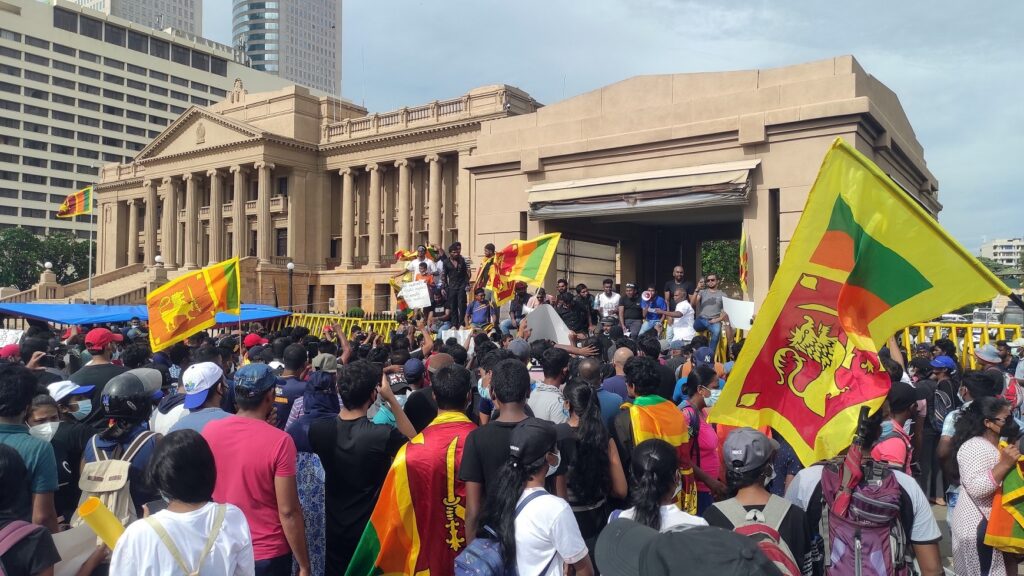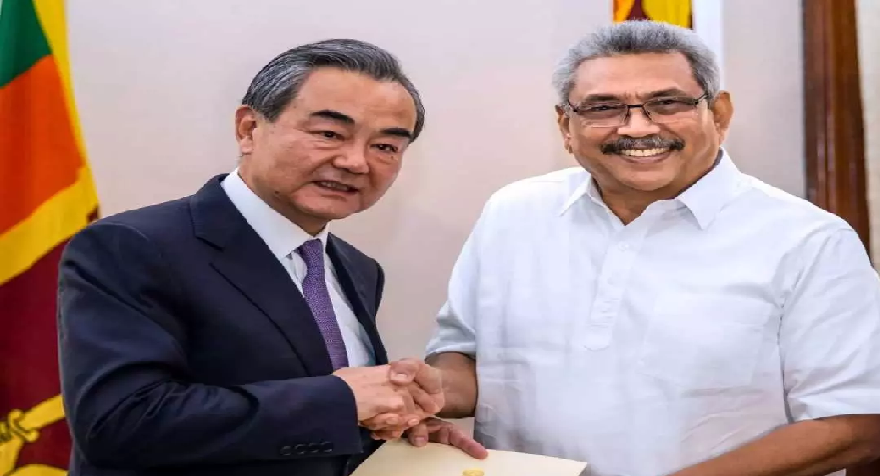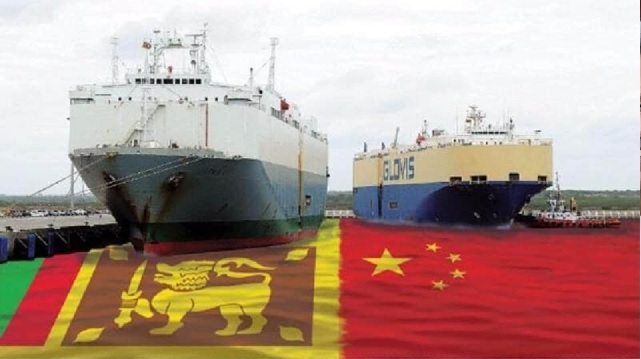
- Protestors opposed the Gotabaya government with the slogan ‘Gota Go Home’ in response to Sri Lankan President Gotabaya Rajapaksa’s mismanagement, corruption, nepotism, and bad governance.
- Relations between India and Sri Lanka deteriorated under Mahinda Rajapaksa’s administration while the President utilised Chinese funding to gain local legitimacy and strengthen his hold on power.
- Keeping with India’s “neighbourhood first” policy, New Delhi has donated over USD 3.5 billion in aid to the people of Sri Lanka this year alone to help them overcome their current difficulties.
- India must acknowledge the Chinese presence and significance of Sri Lanka in its strategic plan and help the island nation come out of this situation.
Introduction
Sri Lanka, an Indian Ocean Island nation with about 22 million populations, is experiencing a severe economic crisis. Many factors are responsible for this crisis—broadly internal and external factors. The internal factors are— poor governance, corrupted politicians, wrong political measures, faulty taxation methods, organic farming, and specific circumstances like COVID-19. The external factors are—the Russian and Ukraine crisis, Sri Lanka’s debt from the foreign country, and business loss due to the lockdown. Due to fuel shortages, people are suffering from the power cut, closing schools, limited working hours, and facing problems with transportation. Apart from COVID-19, the Russia and Ukraine war has severely affected Sri Lanka’s tourism sector. Russia is also the second-largest market for Sri Lankan tea, the country’s primary goods export. The country is currently unable to pay for its essential imports due to a $50 billion external debt and a lack of foreign exchange reserves. As a result, essential goods such as rice, fuel, and pharmaceuticals have suffered significant price hikes. The government devalued the Sri Lankan rupee; the idea was to encourage remittance and qualifying loans from IMF.
Economic Failure
In recent years Sri Lanka has been facing a challenging phase. The COVID-19 pandemic cost the Sri Lankan economy more than $3 billion in the first half of 2021. Many people rely on the $4.4 billion tourism sector, which saw a 70% fallout in May 2019 due to Easter Sunday terrorist attacks. The pandemic has devastated global investors and tourist confidence in the country. Parts of Sri Lanka’s $51 billion external debt have been suspended because its current debt is 110 per cent of its GDP. Large-scale foreign loans with extremely high-interest rates were required for still-ineffective projects like airports and shipping ports. Due to the mishandling of policy, and more import of goods, the country has defaulted on $51 billion in external debt.
According to critics, the root cause of this economic crisis is mismanagement by consecutive governments. The Gotabaya Rajapaksa government promised people during the election manifesto that it would cut taxes, and the government banned chemical fertilisers and pesticides and introduced organic farming. This organic farming leads to 40% less production, and the country faces an immense food shortage. After the country devalued its currency, it faced shortages of basic necessities like food, gas, and milk and rising inflation. Ranil Wickremesinghe, the new Prime Minister of Sri Lanka, said that the country urgently needed $75 billion to help deliver necessary items. However, the country’s treasury is struggling to find even $1 billion.
Where is Governance?
The island nation has been in turmoil throughout this year, and widespread agitations engulfed the entire nation. Hundreds of protestors opposed the Gotabaya government with the slogan ‘Gota Go Home‘ in response to Sri Lankan President Gotabaya Rajapaksa’s mismanagement, corruption, nepotism, and bad governance. They were demanding Gotabaya’s resignation. After his appointment, he amended the constitution, known as the 20th amendment, where all the executive power was vested and concentrated in the hand of the President. According to some sources, the Rajapaksa family controls around 75% of the country’s finances. South Asian nations are familiar with the idea of dynastic politics. It is usual for members of one family to hold high government posts, from the Gandhis in India to the Bhuttos in Pakistan. However, Rajapaksa in Sri Lanka has played a crucial role in dynastic politics. In the 2019 election, Gotabaya Rajapaksa was elected as President. He appointed his brother Mahindra Rajapaksa as Prime Minister, and other Rajapaksa’ joined the government as ministers of sports, irrigation, finance, and agriculture.

In the past, Sri Lanka has always tilted towards China. With China‘s assistance, the Mahindra Rajapaksa government launched important transportation projects like the Narocholai power plant, Hambantota, Mattala Airport, Colombo International Container Terminal, and Lotus Tower. According to the Chatham House report, the Chinese infrastructure spending in Sri Lanka from 2006 to 2009 was $12.1 billion, approximately 14% of the country’s 2018 GDP. There was a $5.4 billion investment before the BRI project (2006-12), which involved 15 projects, and $6.8 billion during the BRI period (2013-2019), including 13 projects. When the crisis came, they found that China was neither a friend in need nor in deed.
Rebalancing the relations with India and China
Relations between India and Sri Lanka deteriorated under Mahinda Rajapaksa’s administration (2005-15). The President utilised Chinese funding to gain local legitimacy and strengthen his hold on power. After India condemned Sri Lanka for violations of human rights throughout its three-decade civil conflict, China and Sri Lanka came closer. They signed several accords with China and a $1.35 billion agreement to expand Puttalam’s coal-fired Lakvijaya Power station and the controversial Hambantota Port, which had been in the works since 2005. Sri Lanka eventually lost the Hambantota Port due to its debt burden. Beijing took over a 99-year lease, an area of more than 15,000 acres surrounding the port. Sri Lanka cancelled the East terminal project, the Colombo port; it was a container terminal undertaken by India and Japan. Among diplomats, there is an accusation that China instigated the trade union to oppose India’s involvement. A month later, they gave it to China. It utilised the chance to enhance its long-established influence in Sri Lanka. To mitigate India’s concerns, Sri Lanka has endeavoured to balance its relations with the country and adopt an India-first policy in October 2020.
After India condemned Sri Lanka for violations of human rights throughout its three-decade civil conflict, China and Sri Lanka came closer.
Moreover, the Sri Lankan leadership recognises that India has always been there for Sri Lanka when it needed it. A relationship with China cannot be built at the expense of India. Sri Lanka, being a small country in South Asia, has tightened its ties with both the Dragon and the Elephant to maintain its progress.
China Factor
Since ancient times, the Indian Ocean has been relevant for its trade route. The contemporary significance of the IOR is used to support Alfred Mahan’s notion that “Whoever controls the Indian Ocean dominates Asia.” The region has played a significant role in world politics in the twenty-first century. Due to the important location of Sri Lanka in the Indian Ocean, it has dragged the attention of the world’s major power. Its strategic importance has been enhanced by its involvement in China’s Maritime Silk Road effort over the Indian Ocean as part of the String of Pearls or what India would call an Encirclement strategy. This strategy could be regarded as a reflection of China’s soft power. It has created a foothold in South Asian countries such as Pakistan, Sri Lanka, Bangladesh, and Myanmar by providing economic assistance to littoral states in the Indian Ocean to build ports. Through this strategy, China wants to encircle India. China’s principal goal in South Asia is to strengthen its control over the Indian Ocean, the world’s busiest marine trading route. China has successfully used the peaceful rise doctrine to improve relations with South Asian states while applying soft power over them.
Sri Lanka eventually lost the Hambantota Port due to its debt burden. Beijing took over a 99-year lease, an area of more than 15,000 acres surrounding the port.

In response to concerns that Chinese loans are “predatory” and that Sri Lanka has fallen into a “Chinese debt trap,” Sri Lankan researchers and officials argue that “such speculations need to be analyzed through a bigger geopolitical lens and oppose pessimism.” China has already committed USD 2 billion to the Hambantota Port Development Project. These investments were made without any research or consideration of alternative repayment options. The port’s current economic non-viability, huge maintenance costs, and large interest payments have put the island nations in a catastrophic ‘debt trap.’ By providing small loans to developing countries, China created a debt trap, gained huge profits, and strengthened its geographical position. When Sri Lanka approached International Monetary Fund (IMF) to bail out, China’s Ambassador to Colombo criticised Sri Lanka for this act while addressing Sri Lankan media. China is opposing Sri Lanka in asking for money from the US, but China is not providing any alternative to come out of this critical situation.
Role of India
As Sri Lanka’s perennial and trustworthy ally, New Delhi always supports her, even during Pandemic times, by providing vaccines and food. In February, India and Sri Lanka agreed to a $500 million credit line for fuel. The Indian government has promised $2.6 billion to Sri Lanka, according to the Indian High Commission, with $436 million in grant aid and $2.17 billion in lines of credit. According to the ministry of external affairs, keeping with India’s “neighbourhood first” policy, New Delhi has donated over USD 3.5 billion in aid to the people of Sri Lanka this year alone to help them overcome their current difficulties. Sri Lanka’s location is crucial for many countries that depend on the Indian Ocean, and it is vital for India because it is nearer to the Indian subcontinent.
Conclusion
Analysing the above discussion as a warning to other South Asian countries with politicised governments and inadequate governance, Sri Lanka’s financial crisis is a typical example of how populist measures, corruption, and poor management can take a nation into these precarious conditions. How a foreign country influences the internal politics of other nations? How corrupt politicians are not thinking about the people of their country? If we look at the economic crisis of Sri Lanka, President Gotabaya Rajapaksa ran away from the country instead of staying there and tackling the situation.
Sri Lanka's location is crucial for many countries that depend on the Indian Ocean, and it is vital for India because it is nearer to the Indian subcontinent.
Another big lesson from this crisis is that nations should be self-sufficient in food production. Accepting cheap Chinese loans and easy credit creates problems for small developing countries. It is a lesson for all South Asian nations about Chinese investment. One question that will continue to haunt us is whether the conflict between the north and south of Sri Lanka is responsible for this political crisis. India must acknowledge the Chinese presence, its strategic plan of the “string of Pearls” and the strategic significance of Sri Lanka and help the island nation come out of this situation. India is capable of helping Sri Lanka to move out of this deep crisis to an extent, along with a bailout from the IMF.
(Sanghamitra Mallick is a PhD. Scholar at the Department of Politics and International Studies, Pondicherry University. Her area of interest includes China in South Asia and the Indian Ocean Region. Views expressed are that of the author)

Very deep descriptive analysis